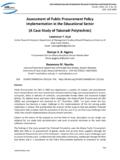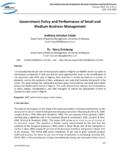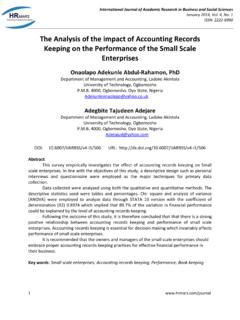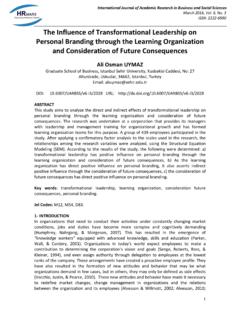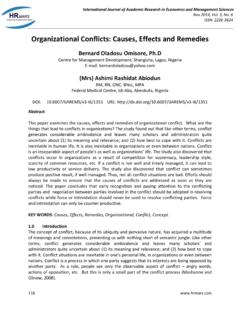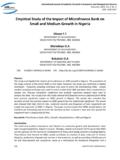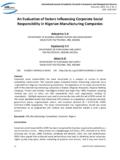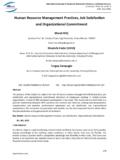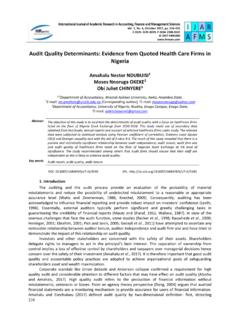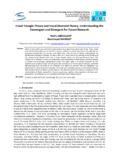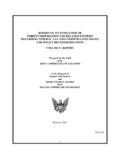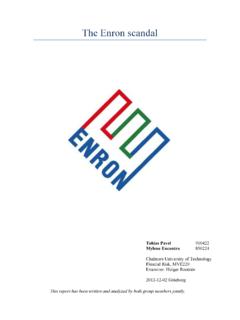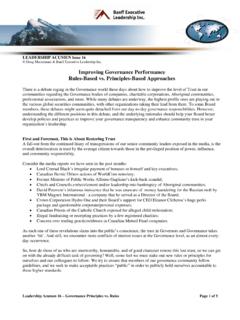Transcription of The Challenges for Establishing the Convergence of ...
1 International Journal of Academic Research in Accounting, Finance and Management Sciences Vol. 4, , April 2014, pp. 144 151. E-ISSN: 2225-8329, P-ISSN: 2308-0337. 2014 HRMARS. The Challenges for Establishing the Convergence of Accounting Reporting Among Different Countries Edwin QUINN Jr. Center for Professional & Continuing Studies, Claflin University, Orangeburg, USA. Email: Abstract The purpose of this study is to exam the Challenges for Establishing the Convergence of accounting reporting among different countries. The role and efforts by the International Financial Reporting Standards (IFRS), the Generally Accepted Accounting Principles (GAAP), and Financial Accounting Standards Board (FASB) are discussed to determine what progress has been achieved towards Convergence .
2 Key words Accounting reporting, IFRS, FASB, GAAP. DOI: URL: 1. Introduction Financial reporting provides an essential tool for determining the health of an organization and forecasting future performance. There are several rationales to analyze financial statements of foreign companies: making investment decisions, merger and acquisition decisions, evaluating foreign suppliers, and comparing against competitors. Best's ( ) study revealed the different users of financial statements: Government officials are generally concerned that reporting and valuation regulations have been complied with and that taxable income is fairly represented. Labor leaders pay particular attention to sources of increased wages and the strength and adequacy of pension plans.
3 Owners, shareholders and potential investors tend to be most interested in profitability. Many investors look for a high payout ratio. Speculators pay more attention to stock value insofar as growth companies tend to have a low payout ratio because they reinvest their earnings. Bondholders are inclined to look for indicators of long-run solvency. Short-term creditors, such as bankers, pay special attention to cash flow and short-term liquidity indicators, such as current ratio. These different users have a diverse of priorities for a corporation. As a result, users analyze the financial statements of an organization to determine if their interests are achieved.
4 Lermack's (2003) study explained there are twelve steps for financial analysis of a company: 1. Review the financial statements (Balance Sheets, Income Statements, Shareholders Equity Statements, and Cash Flow Statements) for at least 3 to 5 years. 2. Scan statements to look for large movements in specific item from different years. 3. Review the notes accompanying the financial statements for additional information. 4. Examine the balance sheet to determine changes in the company's assets, liabilities or equity. 5. Examine the income statement to look for trends over time. 6. Examine the shareholder's equity statement to determine if the company has retained earnings account been growing or shrinking.
5 7. Examine the cash flow statement for information about operations, financing, and investing. 144. International Journal of Academic Research in Accounting, Finance and Management Sciences Vol. 4 (2), pp. 144 151, 2014 HRMARS. 8. Calculate financial ratios to find favorable or unfavorable trends. 9. Obtain data from the company's key competitors and the industry. the market data about the company's stock price and the price to earnings ratio. the dividend payout to assess long-term strategies of the company. all the data collected to determine if the company is worth investing in for the long term. Depending on the goals of the decision-maker, focus on a specific financial statement can provide essential information.
6 For example, for decisions of mergers and acquisition financial due diligence is required to assess investment requirements. Additional information beyond the financial statements is required such as income tax returns, statutory accounts, and minutes from management meeting. 2. Literature review Attempts to establish comparability accounting information across firms in different countries was implemented by the International Financial Reporting Standards (IFRS) in 2005. The primary goal of the IFRS. was to reduce the costs of analyzing financial statements and increase the usefulness of information for financial statements users (Kang, 2012). Initially, comparability of earnings and book values occurred.
7 Overtime, there was a decrease in comparability by firms due to aligning report that provided the best incentives. Kang's (2012) study revealed accounting harmonization across different countries with different enforcement mechanisms, incentives of managers, cognitive biases and cultural differences provides a Challenges process to produce comparability. Further evolution of accounting standards is needed to ensure transparency and the protection of investors. The IASB process of Convergence is vulnerable to influence by certain external factors that include the following (Sacho and Oberholster, 2008): Political influence of lobbyists and suppliers of funding.
8 US influence on international accounting standard setting;. Accounting scandals as a result of misapplication of the principles-based accounting standards;. Different interpretations and applications of accounting standards due to cultural differences. It is possible that some of these factors will hinder the ability of Convergence and the potential to make a considerable impact on accounting standards. CPAs' and CFOs' attitudes toward harmonization of international accounting Harmonization of international accounting reporting practices has received substantial attention to enhance transparency. Globalization has increased the flow of capital across national borders and into emerging markets.
9 Nguyen and Tran Dinh's (2012) study discussed, The process of Convergence with IAS/IFRS is determined by examining the extent to which new standards reduce the gaps between national accounting standards of a particular country and international standards. The process of harmonization would be bene cial to such stakeholders as multinational enterprises, international accounting rms and domestic rms themselves. The implementation of harmonization of accounting practices will save resources and enhance the reliability of financial reporting. Barniv and Fetyko's (1997) study examined the attitudes of CPAs and financial executives (CFOs) toward harmonization of accounting standards.
10 Survey instruments were mailed to a sample of and international CPAs with four of the Big 6 CPA firms and CFOs with firms on the Fortune 200 list and other clients of the participating Big 6 CPA firms. The study concluded that overall attitude of all respondents toward harmonization was positive. The international CPAs were much more positive toward harmonization than the CPAs and the CFOs (Barniv and Fetyko, 1997). Overall, the major CPA firms and multinational firms tend to support harmonization even with potential increasing costs which they believe are not substantial (Barniv and Fetyko, 1997). The quality of the international accounting standards The quality of international accounting standards varies by foreign countries due to ethical standards, social values, and political systems.
